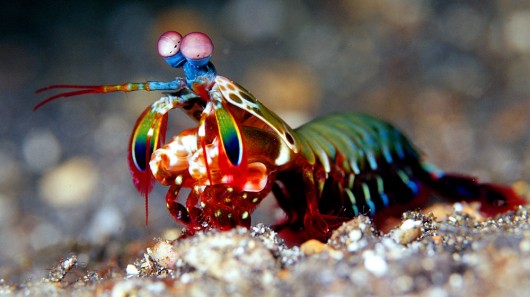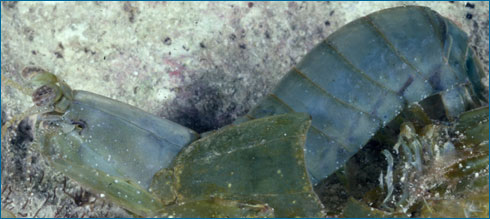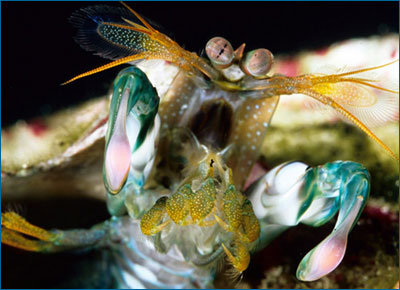Mantis Shrimp
Leah Cepko & Mason Kennon
Reed College: Biology Department (Animal Behavior - Fall 2014)

Ontogeny
Image courtesy of UC Berkeley--Evolution webpage
Ontogeny pertains to the development of a given behavior over an organism’s lifetime. There is very little research concerning genetic and learned elements of stomatopod feeding behavior and the timing of its development over the course of the individual's life history. As a result, we focus on the constraints imposed by the cyclic molting process, necessary throughout the individual's lifetime. Behavior here is more broadly understood in the continuous life cycle morphogenesis on the exoskeleton of the mantis shrimp. The amazing capabilities of the raptorial appendage cannot be understood without acknowledging the effect this exoskeleton structure has throughout the mantis shrimp life cycle. The mantis shrimp has come to be an important organism for research on the evolution of the exoskeleton and how organisms mediate the constraints posed by it. One important cost of the exoskeleton is the necessity to molt, or shed the outer tissue layer regularly. Molting prevents the continual break down of this exterior defensive structure. Molting periods leave the organisms particularly vulnerable to external forces while the new exoskeleton develops. Unfortunately, there is little research investigating the effects of molting on the prey capturing systems of mantis shrimp. Nevertheless, by examination of research pertaining to the effect of the molting process on intraspecific competition, we hope to demonstrate, by analogy, the potential changes in mantis shrimp behavior due to the constraints imposed by the molting process. Additionally, the behaviors of individuals during the molting period is affected by prior experience, and thus changes slightly over its lifetime, as it encounters novel and familiar conspecifics and utilizes information from previous interactions to decide between tactics utilized.
Molting
Mantis shrimp must molt roughly every 2 months. During molting, the exoskeleton splits and the organism wriggles out of this newly shed layer. This leaves the individual vulnerable to attack for several weeks before the new exoskeleton has achieved sufficient durability to withstand the force applied by a potential predator. Different species have evolved different strategies to combat this physically compromised period. Research has demonstrated that intraspecific competition in mantis shrimp species can be particularly fierce as individuals compete to gain or maintain territory in the cavities of coral rubble in which they inhabit.
Image courtesy of UC Berkeley--Evolution webpage
Threat Displays During the Molting Period
Furthermore, these stomatopods are capable of remembering the outcome of contests with competitors through utilization of chemical cues. Thus mantis shrimp species form stable hierarchies based upon actual or ritualized combat. Because of such intense intraspecific competition, mantis shrimp species have evolved interesting bluffing behaviors during the molting period. Surprisingly newly molted individuals perform a higher frequency of threat displays despite their soft condition (Steger & Caldwell, 1983; Adams & Caldwell, 1990). This display includes elevation of the appendages overhead so as to demonstrate size to potential competitors. This is a classic form of dishonest communication, as the organism is not actually in a state to combat and conquer any intraspecific competitors. However, such ritualized aggression actually minimizes the likelihood that an interaction with a competitor will result in a physical fight, which could seriously damage an individual during the molting period. This demonstrates that individuals significantly modify their behavior during the molting process in order to minimize potential damage to themselves in their weakened state. Such avoidance of potential external forces may also be true of mantis shrimp prey capturing systems but further research is necessary to evidence this hypothesis.

